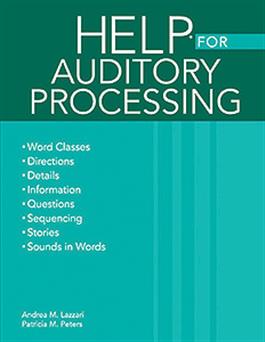
Handbook of Exercises for Language Processing HELP for Auditory Processing
Product Code : MPS8-31608
$88.00
Vendor: PRO-ED
Available
Andrea M. Lazzari Patricia M. Peters Description Ages: 6-Adult Grades: 1-Adult Students receive, interpret, and internalize language presented in the auditory mode with hundreds of stimulus items arranged by...
Andrea M. Lazzari Patricia M. Peters
Description
Ages: 6-Adult Grades: 1-Adult
Students receive, interpret, and internalize language presented in the auditory mode with hundreds of stimulus items arranged by discrete skill and level of difficulty.
Written in the best-selling format of the HELP series, these lessons have:
- goal-driven activities
- high quality, timeless content
- appeal to a broad age-range
- gradual increase in complexity within and between activities
- application to a wide range of developmental and acquired disorders
The activities in this book develop functional auditory-linguistic skills that support language and reasoning. Stimuli require active thinking as well as processing. All of the tasks can be presented orally to the client or used as worksheets.
The book is divided into eight sections:
- Word Classes: recognize and relate items by word class; identify word classes; build word associations; understand word classes for problem solving
- Directions: identify important information in directions, information missing from directions, and the number of steps in directions; paraphrase directions; follow conditional directions
- Details: identify specific information in directions; explain absurdities; correct factual errors; identify opposites, synonyms, pronoun referents, and details in statements
- Information: determine what information is needed and sources of information; judge the quality of information; use information to make inferences and decisions; identify relevant information
- Questions: answer questions about objects, word classes, and activities; choose appropriate questions; use questions to gather information
- Sequencing: put information in order; sequence by physical features and historical events, identify steps in common events, sequence life events; understand sequences in paragraphs
- Stories: identify characters, places, and times in stories; choose story titles; paraphrase stories; infer from stories; ask questions after listening to stories
- Sounds in Words: recognize and identify initial, medial, and final sounds in words; identify like sounds and hard and soft sounds
190 pages 8.5 x 11, softcover 1994














